If you have a child who likes coding, chances are you’ve heard of Code.org games. Code.org, a non-profit dedicated to building coding competencies and supporting students from underrepresented groups, is a common and useful site for learning how to code. Today we'll share two of Code.org’s great tools: Game Lab and App Lab. These two tools can be used to build Code.org games, and other applications and share them with friends. I'll share some of my favorite games for kids to enjoy coding, as well as some games that are best for each grade level, and even some Minecraft games - since it's so popular!
Explore Code.org's Game Lab and App Lab
Code.org is a great resource for young coders who are just at the beginning of their programming education. The site offers fun games, development platforms, a safe way to share code and see peers’ work, and more. Every year, Code.org also hosts Hour of Code, a program which is used to crowdsource lots of great coding projects and can help introduce coding in schools or at home.
To get kids started with coding, Code.org offers two key in-browser applications: the Game Lab and the App Lab. Both applications are development environments that allow students to create their own programs using code blocks. There are many starter projects and walkthrough projects that are accessible to beginner coders, but plenty of options for intermediate or advanced students as well. App Lab is more suited to older, more experienced coders and offers a text-based coding option, while Game Lab is great for younger kids who want to get their feet wet.
For live guidance making cool games, enroll your child in an award-winning online Scratch coding class designed by experts from Google, Stanford, and MIT.
Discover Free Games on Code.org
Discover several different Code.org games that you can play, customize, and modify. While there are many, many examples of Code.org games, these ones are both fun to experiment and interact with and great at teaching coding concepts.
1. Code.org Sports Game
Code your own sports game is a code.org application that walks you through using code blocks to build a simple game. You’ll start on level 1, solving increasingly more challenging puzzles until you have coded out a whole game.
This one’s pretty straightforward to start, as it is geared towards beginners and has clear directions. Follow the instructions at the top of the screen, and click “run” once you have placed your blocks to make the code work and pass the level. Sports game is great for students who have no experience programming and who want a directed approach to learning.
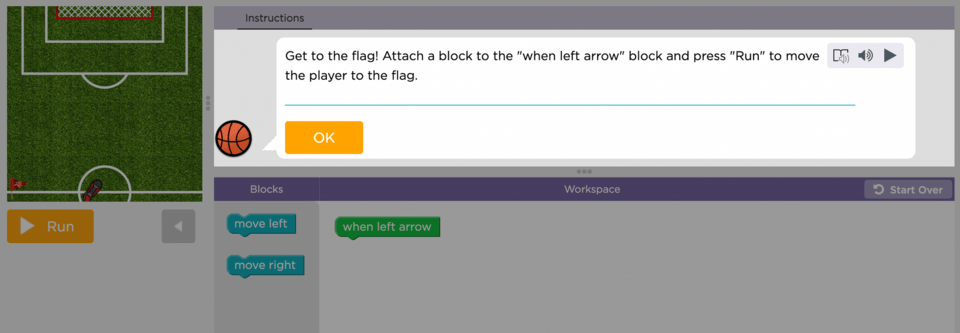
2. Code.org Dance Party
Dance Party is similar in feel to Sports Game in that it will guide you through the creation of a full program, block by block. Instead of a sports theme, however, you’re building characters that can dance to your favorite songs.
Once again, follow the instructions at the top of the screen to get started. This one’s a little more tricky than Sports Game, so make sure you feel confident in Sports Game first before moving on to this set of challenges. Don’t forget to pick your favorite song!
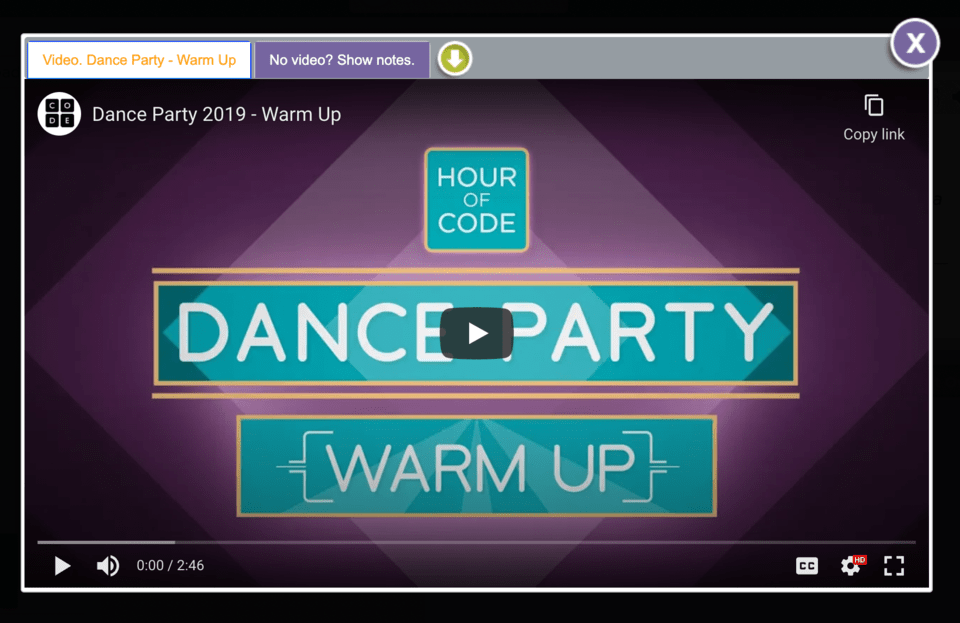
3. Poke the Pig Game
Reminiscent of “old internet,” Poke the Pig is a silly, yet entertaining program that can be easily modified. To play this game, click “run” and then poke the pig as many times as you can in ten seconds.
Poke the Pig is a great project to work on after you have mastered Sports Game and Dance Party. Want to make this game your own? Remix it and add to it! The comments in the code blocks offer ways to improve or enhance the existing game. You could also change the pig to a different animal, or even let the user choose which animal they’d like to see.

4. Slider Sketch Game
When learning how to code, drawing apps are a great way to get instant, visual feedback. That’s why we like code.org’s Slider Sketch. Slider Sketch is a digital Etch-a-Sketch that lets you draw pictures by moving your cursor left, right, up, and down. Create skylines, abstract art, or even write your name!
There are numerous ways you can customize this project. Remix it, and then experiment with different parameters. Can you figure out how to change the color of the pen? Examine the code blocks that use the slider as an input. Can you add a slider that allows the pen to move diagonally?
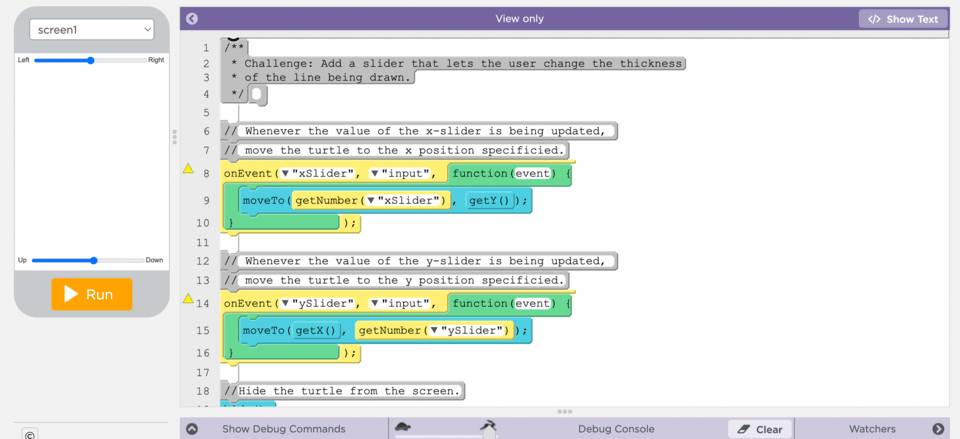
5. Code.org Bounce Game
The Bounce Game is your typical, pong-style tennis game. As you play, you move your paddle back and forth to intercept the moving ball before it drops below the screen, and try to score points by aiming the ball at coins that appear. Be careful, though - the better you do, the faster the ball will move.
The code for this game is already written out completely, but you can remix and create your own version! Start by examining all the variables, defined in purple blocks at the top of the code, and change a few like paddleWidth or coinDiameter to change the game parameters. Can you figure out how to change the ball speed?

6. Choose Your Own Adventure Game
A classic intro coding project is creating a Choose Your Own Adventure or RPG-style story game. As a player, you read a story prompt and then pick your next move from the dropdown options menus below. Based on the choices you make, you’ll create your own, unique story!
Code.org’s Choose Your Own Adventure project can be customized or expanded in a ton of different ways. You can easily change the story, come up with a totally new theme, or add more options or paths. Make sure you explore not just the code tab, but also the design tab to change the existing story screens or add new ones.
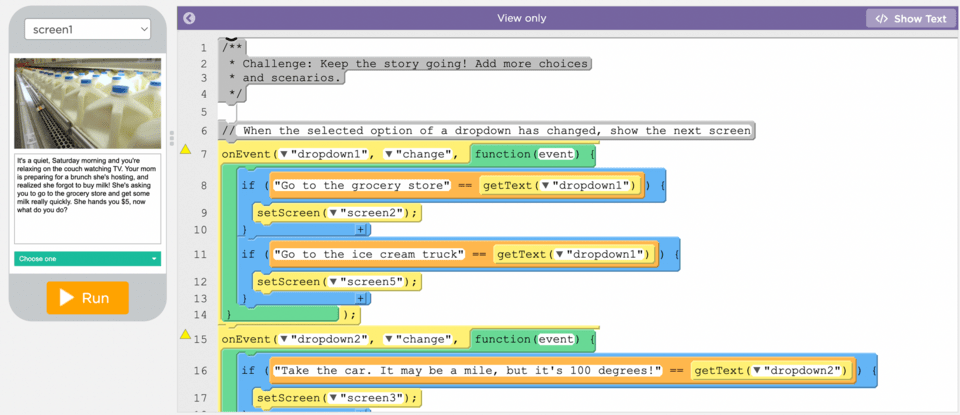
7. Voting App Game on Code.org
The final project we recommend checking out is Code.org’s Voting App. In this application, you can poll your friends and create a pi chart which represents the results. The original asks you to vote “cat or dog?” but you can get creative here.
Remix this project and change up the polling question (and images that go with it). You can also add a third or fourth poll option, change the look of the application, or even experiment with different types of plots.
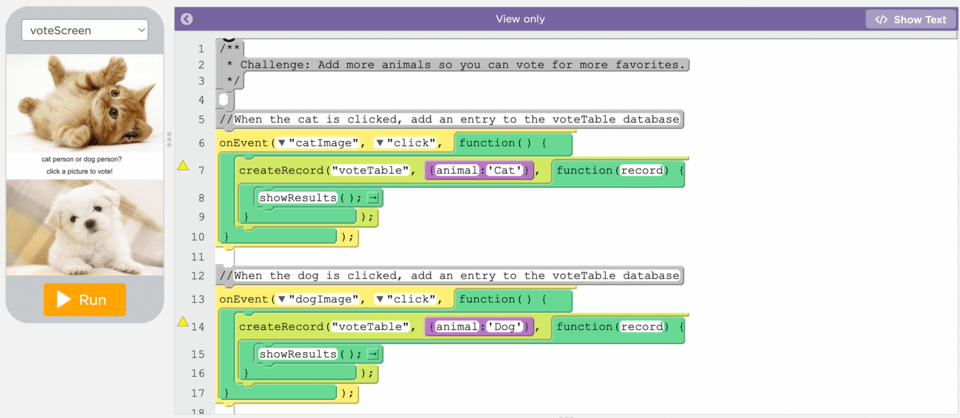
Discover Code.org Games By Grade Level
1. Code.org Pre-reader Games
Make the sun set. "Can I Make the Sun Set?" is an introductory activity meant for children in kindergarten through second grade with little to no programming experience to learn the basic features of ScratchJr and the elementary concepts of coding. Through this activity and continued time with ScratchJr, students will have the opportunity to think creatively, become storytellers, and improve upon mathematical reasoning and sequencing skills. Later, children can use the skills they have learned to create their own unique projects.

2. Code.org Grades 2-5 Games
Save the forest with a game designed by Microsoft. Code a game with Microsoft MakeCode Arcade that recreates the conditions for a forest fire, and then code your fire-fighting airtanker plane to spray water and put out the flames! Or code your own sports game with a fun adventure designed by Code.org. Choose between making a basketball game or mix and match across sports!

3. Code.org Grades 6-8 Games
Design a basketball game. Learn the basics of coding in Python while creating your own basketball game. You'll learn how to add backgrounds and sprites, and how to use events to control the motion of sprites on the stage. Or try Harry Potter magic! Learn to code and make magic on screen with creative challenges. Make feathers fly and fire flow, compose music, and more.

4. Code.org Grades 9-12 Games
Create a photo filter with a project from Google. Learn coding skills to create filters to apply to different photos. Or make your own beats. With this video lesson project, students explore how coding is used in music creation by building their own dynamic eight-count beats and patterns with JavaScript blocks!

Explore Code.org Minecraft Games
Because kids love playing the video game Minecraft, it's also become a popular medium for learning coding. Once students learn Minecraft modding they can bring fantastically creative world's to life. So Code.org offers a ton of ways to get started with Minecraft coding for students in grades 2 and higher.
In Minecraft Voyage Aquatic, students explore and code underwater worlds. With Minecraft Hero's Journey, students are challenged to complete an interesting journey, by learning more coding fundamentals. In Minecraft Timecraft, students can travel back through history. These cool Microsoft programs are a great way for your child to build their digital skills and get more involved in computer science.

Kids can also learn and apply their coding power to escape Dr. Breakowski’s mysterious mansion by dawn in the Minecraft Escape Estate game. Your child can even get help from a live instructor in our Minecraft Escape Estate event, as they solve puzzles using computational thinking to unlock secrets, open trap doors, and reveal hidden clues.
Get Started With Code.org Games
Now you and your child know all sorts of fun games and applications to begin learning! If your child enjoyed these programs, they may also like learning more about Scratch, an extremely popular block-coding language for beginners. Save your child's spot in one of our free Scratch Ninja classes to learn live from an expert in a fun small group setting.
Written by Sarah Rappaport, who graduated from Northwestern University with undergraduate and graduate degrees in engineering and music. She's now working on a masters in data with Georgia Institute of Technology. She taught math and computer science with Teach for America for two years, and now works as a Systems Engineer.




